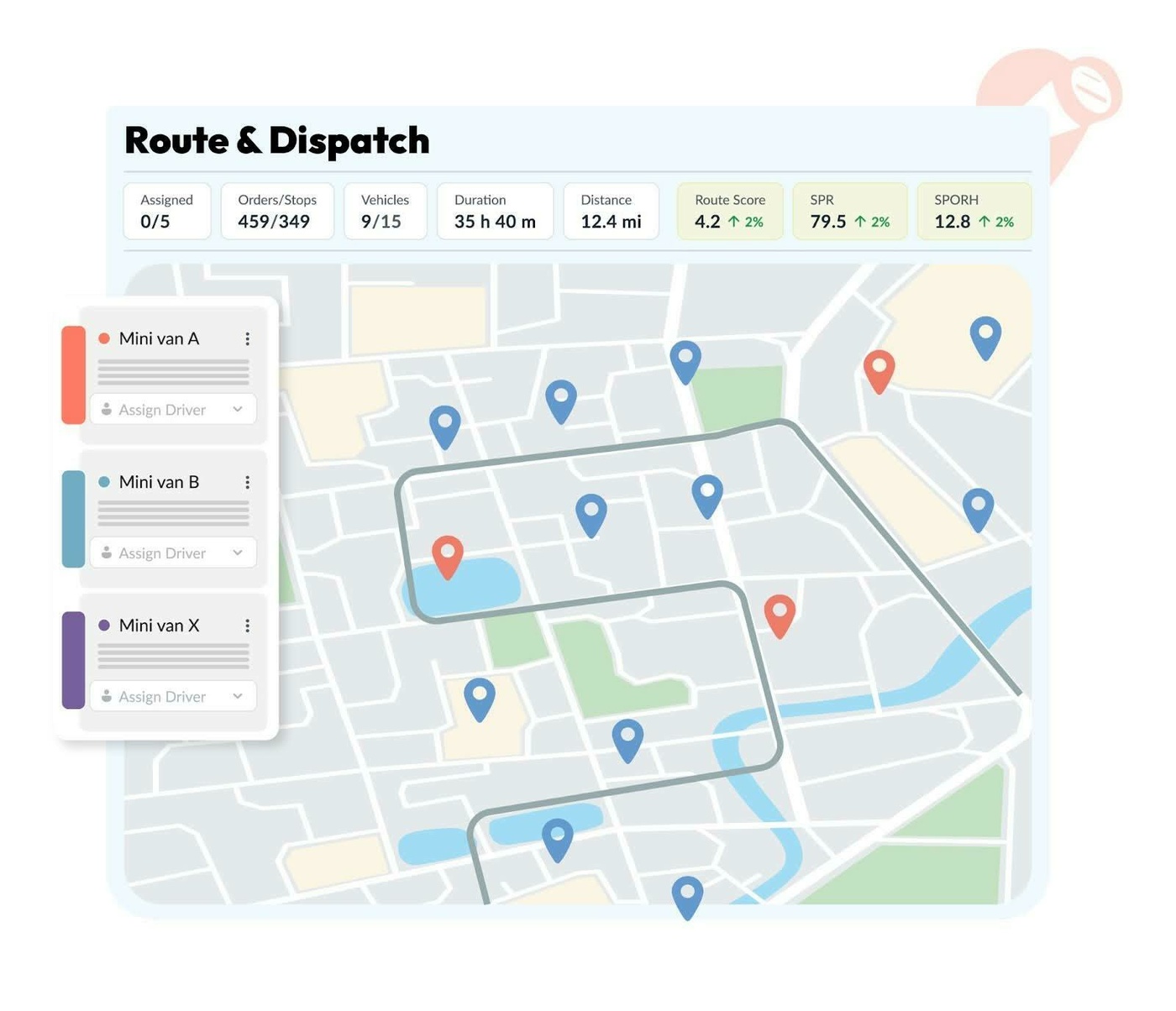

Why Route Mapping Matters for Complex Delivery Networks
By Komal Puri | November 26, 2024
As businesses scale their operations and customer expectations escalate, managing complex delivery networks has transformed into a daunting challenge. In the United States alone, e-commerce sales are projected to reach a staggering $1,223.00 billion in 2024, and with a projected growth rate of 8.99% annually, the demand for efficient delivery solutions is more critical than ever.
Whether delivering thousands of parcels across urban landscapes or ensuring groceries arrive at doorsteps while still fresh, the effectiveness of your delivery system can directly impact customer loyalty and your bottom line.

A key factor in achieving smooth, timely deliveries is route mapping—a sophisticated process designed to optimize delivery routes for efficiency, cost-effectiveness, and reliability. In fact, studies show that businesses can reduce transportation costs by up to 20% through effective route optimization.
For enterprises where timely deliveries are not just important but essential, adopting advanced route mapping solutions is crucial. These tools not only bolster operational efficiency but also significantly enhance customer satisfaction, driving down costs while meeting the rising expectations of consumers.
What is Route Mapping, and Why Does it Matter?
At its core, route mapping is the process of creating the most efficient routes for deliveries, ensuring that orders are fulfilled in a timely and cost-effective manner. For businesses where logistics costs are a significant constraint, this process becomes even more critical.
Effective route mapping takes into account various factors such as traffic conditions, vehicle capacities, delivery time windows, and road restrictions, allowing companies to maximize operational efficiency while minimizing costs. By optimizing routes specifically tailored to their logistical constraints, businesses can significantly reduce fuel consumption, improve delivery times, and ultimately enhance their profit margins.
But why is it so important? For enterprises managing large-scale delivery operations, the difference between manual route planning and automated route mapping can be staggering. Manually plotting routes for hundreds or thousands of deliveries is time-consuming, prone to errors, and fails to account for real-time factors like road closures or weather conditions.
In contrast, route mapping software uses sophisticated algorithms to automatically optimize delivery routes based on the latest data, providing businesses with significant benefits, including:
- Faster Deliveries: Optimized routes ensure that deliveries are made in the shortest possible time, reducing delays and improving customer satisfaction.
- Cost Reduction: By minimizing travel distances and avoiding congested routes, businesses can save on fuel, labor, and vehicle maintenance costs.
- Improved Resource Allocation: Route mapping helps businesses make the most of their available fleet, ensuring that each vehicle is used to its full capacity.
- Scalability: As businesses grow, route mapping software scales seamlessly to handle larger volumes of deliveries without adding complexity.
- Real-Time Adaptability: Advanced route mapping tools can adjust delivery routes on the fly based on real-time data, such as traffic updates or weather conditions.
Parcel Routing: Optimizing Bulk Deliveries
For enterprises in industries such as retail and apparel, managing a high volume of smaller parcels presents unique logistical challenges. Often, these businesses must coordinate thousands of deliveries within tight time windows, balancing speed with the desire to minimize costs. This is where route mapping proves invaluable.
With FarEye’s route mapping software, dispatchers can allocate bulk orders in less than 30 minutes—a task that could otherwise take hours using manual methods. The software can solve up to 100 constraints simultaneously, considering factors like delivery locations, vehicle capacities, traffic patterns, and customer preferences to ensure that every route is optimized for efficiency.
Moreover, FarEye’s advanced analytics provide businesses with insights into delivery performance, helping them identify areas for improvement and fine-tune their operations. By automating the parcel routing process, enterprises can handle large volumes of orders with ease, ensuring that deliveries are made on time, every time.
Truck Routing and DOT Compliance: Ensuring Safety and Efficiency
Truck routing adds another layer of complexity, particularly for businesses dealing with large and bulky items like furniture. These deliveries require careful planning, as trucks must navigate routes that accommodate their size and weight while also adhering to safety and regulatory guidelines.
One of the most critical factors in truck routing is Department of Transportation (DOT) compliance. DOT regulations govern the safe operation of commercial vehicles, and failing to comply can result in hefty fines and operational disruptions. Key aspects of DOT compliance that businesses must consider include:
- Hours of Service (HOS)
Drivers are legally limited in how many hours they can work per day and per week to prevent fatigue. Route mapping software can ensure that routes are planned to keep drivers within these limits, avoiding violations.
- Weight and Size Restrictions
Trucks are often restricted from using certain roads or bridges due to weight or height limits. Route mapping software can account for these restrictions, ensuring that deliveries are routed through appropriate roads.
- Inspection and Maintenance Schedules
DOT regulations require regular vehicle inspections and maintenance. FarEye’s software can integrate maintenance schedules into the routing process, ensuring that only compliant vehicles are used for deliveries.
By incorporating DOT compliance into the route planning process, FarEye’s software helps businesses avoid legal issues and maintain the safety of their fleet while optimizing truck routing for large and bulky deliveries.
Food and Grocery Routing: Delivering Freshness with Precision
When it comes to the food and grocery industry, timely deliveries are not just a matter of convenience—they are a matter of necessity. Fresh produce, perishable goods, and prepared meals must be delivered within specific time windows to ensure that they arrive in peak condition. The challenge for businesses in this industry is to manage tight delivery schedules across vast geographic areas while minimizing operational costs.
Route mapping is essential for optimizing food and grocery deliveries. FarEye’s routing software allows businesses to plan the most efficient routes for their delivery fleet, considering factors such as:
- Perishable Goods Routing
Time-sensitive deliveries require precise planning to ensure that food reaches its destination before spoilage. FarEye’s real-time routing updates ensure that any disruptions—such as traffic jams or vehicle breakdowns—are accounted for, and alternative routes are provided instantly.
- Multiple Delivery Points
Food delivery services often have to manage multiple deliveries within a short time frame. FarEye’s software clusters deliveries based on proximity, allowing businesses to handle higher volumes without compromising on delivery speed.
- Dynamic Route Adjustments
In an industry where traffic, weather, and customer preferences can change rapidly, FarEye’s software provides dynamic route adjustments in real-time, ensuring that deliveries are completed efficiently despite external factors.
Big and Bulky Routing: Managing Large Deliveries Efficiently
Delivering big and bulky items, such as furniture, home appliances, and large retail goods, presents its own set of challenges. Unlike parcel deliveries, these items require specialized handling, larger vehicles, and more detailed planning.
Route mapping becomes essential in managing these logistics, ensuring that deliveries are completed efficiently and without damage to the goods. FarEye’s route mapping software simplifies the process of managing large deliveries by offering:
- Vehicle Capacity Optimization
Route mapping software ensures that the right-sized vehicles are assigned to the appropriate deliveries, reducing the risk of under-utilized or overloaded vehicles.
- Handling Constraints
For large deliveries, businesses must consider factors like delivery team size, equipment availability, and customer preferences. FarEye’s software integrates these constraints into the routing process, ensuring smooth and efficient deliveries.
- Reducing Failed Deliveries
Big and bulky deliveries are costly to fail. With FarEye’s software, businesses can ensure that delivery windows are respected, routes are optimized, and customers are informed of the delivery status in real-time, reducing the risk of failed or delayed deliveries.
Why FarEye is the Perfect Solution for Route Mapping
FarEye stands out as a leader in route mapping software, providing enterprises with the tools they need to manage complex delivery networks.
With a focus on industries like retail, fashion, furniture, and food, FarEye’s software integrates seamlessly into existing systems, offering businesses a comprehensive solution for optimizing their delivery operations.
FarEye’s advanced features include:
1. Automated Route Planning:
Quickly and accurately generate optimized routes for bulk deliveries, significantly reducing planning time and enabling faster service.
2. Real-Time Tracking
Monitor deliveries in real-time, allowing for dynamic route adjustments based on current traffic conditions, weather disruptions, or vehicle breakdowns.
3. In-Depth Analytics and Insights
Access detailed analytics that not only evaluate delivery performance but also identify areas for improvement, helping to refine your logistics strategy.
4. API Integrations
Seamlessly integrate with various existing systems, allowing for smooth data exchange and enhancing overall operational efficiency.
5. User-Friendly Mobile App
With an intuitive mobile application, drivers can easily access routes, receive real-time updates, and communicate with dispatchers, fostering better coordination.
6. Machine Learning Capabilities
Leverage advanced machine learning algorithms to analyze historical data and predict future delivery patterns. This enables more accurate route planning and demand forecasting, helping businesses anticipate needs and allocate resources effectively.
7. Scalability
FarEye’s software scales with your business, accommodating increasing delivery volumes without adding complexity, ensuring your logistics operations can grow without hindrance.
By leveraging these differentiators, FarEye empowers enterprises to streamline their delivery processes, enhance customer satisfaction, and ultimately drive down operational costs.
Ready to Optimize Your Delivery Network with FarEye?
Enterprises across industries are facing increasing pressure to improve delivery performance, reduce costs, and enhance customer satisfaction. With FarEye’s route mapping software, businesses can streamline their logistics operations, ensuring faster deliveries, lower costs, and a better customer experience.
Are you ready to transform your delivery operations? Connect with experts at FarEye today and discover how our cutting-edge route mapping software can help you manage even the most complex delivery networks with ease and efficiency.

Komal Puri is a seasoned professional in the logistics and supply chain industry. As the AVP of Marketing and a subject matter expert at FarEye, she has been instrumental in shaping the industry narrative for the past decade. Her expertise and insights have earned her numerous awards and recognition. Komal’s writings reflect her deep understanding of the industry, offering valuable insights and thought leadership.


